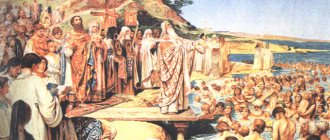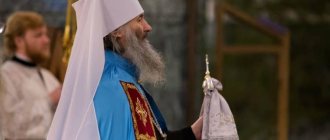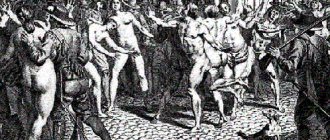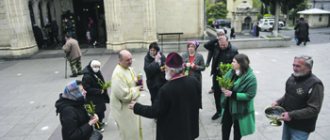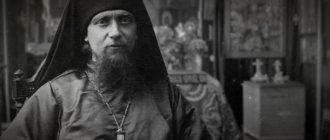The Holy Synod is the church government, that is, the highest church body that has the most important power in the church and interacts with the churches of other states.
His actions spread throughout the entire synodal period from 1721 to 1917. The members of the Synod were appointed by the Emperor of the Russian Empire, and its chairman was the Chief Prosecutor.
This definition is discussed in detail in history lessons in schools. Below are the main points you need to know for credit and a good grade.
Reasons and goals for the creation of the Holy Synod
There are rumors that initially Peter I did not plan to change the established church order. But the further his reforms progressed, the less he wanted to share power with anyone else, and especially with such a strong rival as the church.
It was for this reason that Peter I decided to lure the church to his side, to make it his ally, turning it into part of the apparatus of governing the empire.
The creation of the governing Synod was the final stage in the church reform of Peter I. This body was created in order to replace the abolished position of the Patriarch and subordinate the church to the Russian Empire.
The orders of the emperor had to be unquestioningly carried out by the Synod, since it acted on behalf of His Majesty.
Probably the most important reason for the creation of the Supreme Governing Synod is that the emperor needed a strong and faithful ally in the person of the Orthodox Church.
As is known at that time, people trusted the church and feared God's punishment like fire. Therefore, having taken power over the church, the first Russian emperor could calmly control the people with its help.
Chapter I. THE RUSSIAN ORTHODOX CHURCH IN THE ERA OF PETER I
Patriarch Adrian
died in 1700. Russia was then experiencing turning point historical events, during which a new image of the state took shape: the army was reformed, the fleet was built, the culture and life of the upper stratum of Russian society was reshaped in a Western European way; On the Baltic coast reclaimed from the Swedes, the new capital of the Russian Empire, St. Petersburg, was built in a matter of years.
Among the transformations of Peter the Great
Church reform was especially important in its consequences, for the main feature of the St. Petersburg period was the absolutism of state power, which differed significantly from the old Moscow autocracy with its traditional customary law and, most importantly, the highest church authority not subordinate to the secular sovereign. The attempts of the Moscow sovereigns to usurp power over the Church were a violation of the norm, and the norm in the relations between church and state power before Peter remained the symphony inherited from Byzantium. By the imperious hand of Peter, the Orthodox Church was pushed away from the main channel of national life. Beginning with Peter I, the secular government began to look at the Church not as the highest shrine of the people, but as one of the supports of the state apparatus, supposedly in need of guardianship and supervision. To do this, the government needed to break the old system of church government, which combined the conciliar principle and the primate leadership, and in its place establish a new one - the synodal system.
The creator of this reform, Peter I, received an old Moscow upbringing, which, however, was not alien to Western influences. He, like his peers, studied from the Psalter and Holy Books, the Book of Hours, but already in childhood he became addicted to illustrated books of foreign press, and then for many years he was captivated by amusing war games with regiments of a foreign system; in his youth, he made acquaintance in the German settlement, which caused horror and disgust among zealots of antiquity, where foreigners lived. The wild Streltsy riot of 1682 made an indelible impression on the soul of the future tsar, when his uncles Alexei and Ivan Naryshkin were torn to pieces in front of the young heir's eyes. From then on, all antiquity in Peter’s mind was identified with indomitable and dark fanaticism.
The love of Russian people of the old style for prostrations and long prayers, for lighting candles in front of icons, for ringing bells, became alien to Peter. The tsar did not attach importance to fasting and even, to the horror of people of strict rules, allowed himself clownish amusements, which they perceived as blasphemy. His teacher is uncle Nikita Zotov
, elevated to the clownish rank of “prince-papa,” for the amusement of the sovereign, in a drunken revel, he distributed “blessings” to the hawkmoths with two cross-folded chibouks. The zealots of antiquity were also bewildered by the tsar’s addiction to tobacco, which Patriarch Adrian associated with a penchant for Western heterodoxy: “Many have become fools from the tobacco pipes and the slander of Luthor, Calvin and other heretics.”
Peter was suspected of non-Orthodoxy, others even of atheism. But he was not an atheist. His faith was firm and strong in its own way. It was expressed in the fact that on Sundays and holidays he prayed unfailingly during the liturgy, often stood on the choir and read the Apostle; He began every business, every military campaign with prayer and the sending of God's blessing, and accompanied every success and every victory with a prayer of thanks. His living faith in God’s providence is evidenced by his often repeated words: “He who forgets God and does not fulfill His commandments, no matter how much he works, will not do much, for he is not blessed from above.”
Peter I spoke about freethinkers with his characteristic rude, forceful expressions: “Whoever does not believe in God is either crazy or naturally insane. A sighted person must know the Creator from his creations.” Characteristic is one of his conversations with the historian Tatishchev, who, having become carried away by extreme rationalism in Europe, once allowed himself, in the presence of the Tsar, to mock and mock the Bible and church institutions. Having struck the freethinker for these speeches with his famous club, the tsar lectured him: “Do not tempt the believing pure souls, do not engage in freethinking that is detrimental to prosperity - I tried to teach you the wrong way, so that you would be an enemy of society and the Church.”
But the sincerity of Peter’s Christian faith did not prevent him from looking at everything through the eyes of a statesman, from the point of view of state benefit. And his political and legal views were formed under the influence of Western Protestant teachings on the primacy of the state in all spheres of people's life, from which the false doctrine of the primacy of the monarch over the Church was derived. However, he was in no hurry to implement his plan to put the Church in the place of one of the departments under his control, but acted carefully and prudently. And the idea itself did not immediately take on the character of a well-thought-out plan. The plan took shape gradually - and the transition period, which was initially thought of as a time of interpatriarchal rule, dragged on for twenty years.
The news of the death of Patriarch Adrian found Peter in the army near Narva. Courier reports flew to him from Moscow. The first proposal to establish an inter-patriarchal “council” came from boyar Tikhon Streshnev, a former enemy and persecutor of Patriarch Nikon. Alexei Kurbatov, who was in charge of the treasury, advised the tsar: “As for the election, sir, of the patriarch, I think it is worthy to wait until the time is right, so that in everything you yourself deign to see your autocracy... From the bishops, sir, for temporary spiritual administration, if you, sovereign, pleasing, it seems to many that Kholmogorsky is kind.”
The proposal to “wait until the election of the patriarch” coincided with the intention of the tsar himself. But for the temporary leadership of the Church, he chose not Archbishop Afanasy of Kholmogory, as Kurbatov advised and as was expected in Moscow, but one of the youngest bishops, Metropolitan Stefan Yavorsky, a learned monk from Kyiv.
The point, of course, was not that the Great Russian hierarchy was depleted of talent. True, some of the Great Russian bishops, frightened by Peter’s innovations, lost their sense of spiritual balance. Like the Old Believers, they saw the reformer tsar as a heretic and even the Antichrist. In 1700, Tambov Bishop Ignatius was brought to criminal court, who encouraged Grigory Talitsky, who read to him his notebooks, in which he proved that Peter was the Antichrist. The Right Reverend, listening to these nonsense, cried with emotion and said: “Pavlov’s lips are yours.” But among the Great Russian hierarchy there were, of course, people of a different type, smart, far-sighted, with a broad outlook.
This was the Kholmogory Archbishop Afanasy mentioned in Kurbatov’s report. In his diocese, he often had to see foreigners, and, to the tsar’s pleasure, he knew how to treat them kindly. This was the same Afanasy who, during the Streltsy riot, was beaten by the schismatic archpriest Nikita Pustosvyat
. Even during the life of High Hierarch Adrian, Peter expressed his desire to have the elderly patriarch as his successor.
Another outstanding archpastor was Metropolitan Job of Novgorod, a monk of the Trinity-Sergius Monastery, patron of education in the Greek-Slavic spirit, a businesslike philanthropist who established schools, hospice houses, and hospitals in his diocese. Metropolitan Job willingly donated diocesan funds for the construction of the fleet and the war with the Turks.
Mitrofan of Voronezh shone as a true luminary in the host of bishops
(1623–1703). Until the age of 40, he served as a parish priest, then, having become a widow, he took monastic vows in the Zolotnikovskaya Hermitage. In 1682, he was consecrated bishop and appointed to the newly opened Voronezh see. At that time it was a wild land, barely touched by Christian enlightenment. During the hierarchal ministry of Bishop Mitrofan, 47 new churches were built in the diocese, and two monasteries were founded. The saint's house served as a shelter for wanderers and a hospital for the sick. A remarkable feature in the life of the saint is his spiritual friendship with Saint Pitirim, Bishop of Tambov.
Peter I became closely acquainted with Saint Mitrofan during the construction of ships at the Voronezh shipyard. The saint saw in this enterprise a godly deed. He considered the war with the Turks, who oppressed the Orthodox brothers for whom the ships were intended, to be the holy war of the Cross with the Crescent, blessed the king for it and happily donated the savings of the diocesan house “for the military.”
But alien to man-pleasing and seeking, Saint Mitrofan was unshakable and fearless when it came to faith. He was upset by Peter's adherence to foreign, “heretical” customs. One day the tsar invited Saint Mitrofan to dinner at his Voronezh house-palace, in front of which there were figurines of half-naked goddesses. Outraged by this wickedness, the saint refused to enter the house. “It is better to die,” he said, “than to approve paganism by your presence or fearful silence. It is indecent for an Orthodox sovereign to install pagan fools.” Confident that the king would order his execution for this daring act, he returned to his place and ordered all the city bells to be rung. And when Peter, surprised by the ringing, asked what it meant, they explained to him: the bishop was preparing for death. Filled with respect for the confessional zeal of the bishop, Peter ordered the statues to be removed.
Before his death, Saint Mitrofan received the great schema with the name Macarius; his death followed on November 23, 1703. Peter took part in the burial of the holy archpastor, who himself carried his coffin to the grave and said after the burial: “I have no other such holy elder left.”
The testament of St. Mitrophan has been preserved, in which there is a wonderful teaching: “For every person this is the rule of wise men: use labor, keep moderation, and you will be rich; drink abstinently, eat little - you will be healthy; do good, avoid evil, and you will be saved.”
But despite all the respect with which the tsar treated such worthy hierarchs as Saints Mitrophan, Job, Athanasius or Metropolitan Tikhon of Kazan, he was embarrassed by the distrust of all of them, even Archbishop Athanasius, in Western European learning and heterodox culture. And most importantly, Peter feared, these bishops might oppose his plan to subordinate the Church to state power. Therefore, Metropolitan Stefan of Ryazan, a native of Little Russia, was preferred to all of them.
Metropolitan Stefan (Yavorsky)
born into the family of an Orthodox Galician nobleman in 1658. He received his education at the Kiev-Mohyla Academy and at Jesuit colleges in Lviv, Lublin, Vilna and Poznan. The teaching in Catholic schools presupposed the Orthodox acceptance of Uniatism. It was a humiliating, but then common “theft of science” in Western Rus'. Returning to Kyiv, the future hierarch renounced his feigned Uniateism and took monastic vows. He was appointed professor at the Academy, where he stood out among his colleagues for his gift of preaching. He knew how to combine in his sermons and “predicates” the sophisticated techniques of Kiev-Polish rhetoric with genuine sincerity of religious feeling, inspiration and cordiality.
In 1700, Metropolitan of Kiev Varlaam (Yasinsky) sent Archimandrite Stefan to Moscow to ordain him as a suffragan bishop. But in Moscow, the protégé happened to pronounce “predika” in the presence of the tsar at the burial of boyar A.S. Sheina. This word delighted Peter. He saw in the speaker a man of European culture, who, as it seemed to him, was superior in his learning to the Moscow “readers.” Peter ordered to place him in the ancient metropolitan see in Ryazan. And less than a year after this elevation, the Council of Hierarchs, on the instructions of Peter, appointed Metropolitan Stephen “exarch, guardian and administrator of the Patriarchal Table.”
The “Exarch and Guardian,” who dreamed of becoming a bishop in his homeland, accepted his appointment with sorrow. Moreover, in Moscow he was greeted unfriendly and even hostile, considered a stranger, and called “an Oblivian, a Pole, a Latin.” The rise of Metropolitan Stephen also alarmed the Orthodox East. A strict zealot of Orthodoxy, Patriarch Dosifei of Jerusalem wrote to Peter in 1702, begging him not to appoint “neither Cherkasy nor Greeks” to the episcopal sees, but only Orthodox Muscovites, “even if they are not wise,” “so that not a Greek gets into the Patriarchate, nor any other breeds of people, that is, from Little and White Russia, who were nurtured and study in Latin and Polonian countries and schools.” And a year later, Patriarch Dosifei sent a message to Metropolitan Stefan himself, in which he sternly warned him that in the East they would not tolerate him becoming a patriarch. It soon became clear, however, that Peter had made a mistake in choosing a locum tenens. Probably, then he had a too simplified idea of the nature of Western education, and he did not imagine that a “Westernist and Latinist” could turn out to be a stronger opponent of church reform in the Protestant way than the Great Russian bishops. Metropolitan Stephen, brought up in Catholic schools, was an ardent champion of the high authority of the Church and its independence from the state.
Like the Great Russian bishops, he dreamed of electing a patriarch. And the zealots of antiquity in Moscow soon realized that in the person of such an unwanted stranger they had found, if not a like-minded person, then an ally, and an unyielding, firm, courageous person. Together with them, the locum tenens did not approve of the tsar’s second marriage, concluded during the life of the forcibly tonsured Tsarina Evdokia Lopukhina
. With indignation, he learned about the abolition of posts in the troops, for which the tsar, bypassing the primate of the Russian Church, secured a letter of permission from the Patriarch of Constantinople. In his sermons, Metropolitan Stefan began to openly denounce those who did not keep fasts, offended the Church and left their wives, transparently hinting at the personality of the Tsar himself.
The relationship between the monarch and the locum tenens became particularly acute after the Tveritinov case. Moscow doctor Dmitry Tveritinov, who studied in the German Settlement, gathered a circle of freethinkers who were passionate about Protestant teachings. His supporters rejected the veneration of holy saints, relics, and icons, rejected the authority of the hierarchy, and did not recognize the sacraments and traditions of the holy fathers. At the same time, in the Tveritin circle, due to theological ignorance, they also rejected the cornerstone of Protestantism - the doctrine of salvation by faith alone. Repeating the ancient Strigolniks, Tveritinov thought that a person is saved not by faith, but by his own deeds and merits, without the mediation of the Church. “I am my own Church,” said the heresiarch. The most zealous of the heretics turned out to be Tveritinov’s relative, the barber Foma Ivanov.
In 1713, the existence of heresy was discovered: the first to be convicted of non-Orthodoxy was a student of the Moscow Slavic-Greek-Latin Academy, Maximov. Metropolitan Stefan immediately organized an investigation, which was conducted publicly and was known in Moscow. Peter, fearing that this noisy process would harm the Germans so dear to his soul, ordered the search to be transferred from Moscow to St. Petersburg to the then newly established Senate. In the Senate, the case ended quickly and easily for the defendants. They were demanded to renounce heresy and were escorted back to Moscow. The locum tenens was ordered to join the repentant to the Church. Metropolitan Stefan, suspecting the apostates of hypocrisy, ordered them to be sent to monasteries to test the sincerity of their repentance. It was then that the justification for his distrust of heretics who so easily escaped punishment was revealed. Prisoner in the Chudov Monastery, Thomas Ivanov, possessed by fury, rushed with a mower to the carved image of St. Alexis and chopped it up. After this atrocity, Metropolitan Stephen convened a consecrated Council for the trial of the criminals. The newly-minted iconoclasts were anathematized, and Thomas, as a malicious and unrepentant heretic, was burned at the stake. The anger of Peter, who learned about the outcome of the new search, was terrible. He suspected the locum tenens that by his harsh judgment of apostates who had fallen into heresy under the influence of the German Settlement, he was inciting Muscovites to pogrom foreigners. Peter ordered the locum tenens to be reprimanded through the Senate.
All those dissatisfied with the reformer tsar looked with hope at Tsarevich Alexei, who sympathized with the sentiments of the zealots of antiquity. Metropolitan Stefan also treated the prince with great warmth. In a word spoken in 1712 on the day of the angel of the heir, he, not without challenging his father, called the birthday boy “the only hope of Russia.” Unambiguously hinting at the king, the preacher continued: “The sea is fierce, the sea is a lawless man, why do you break, crush and ravage the shores? The shore is the law of God, there is a shore - do not commit adultery, do not lust after your neighbor’s wife, do not leave your wife; There is a shore to preserve piety, fasting, and especially the Pentecostal period.” And six years later, two terrible cases were discovered: first the prince, and then his mother Evdokia, were accused of conspiring against the tsar. Clergymen were also involved in these cases. The prince’s confessor, Archpriest Jacob Ignatov, when Alexei repented to him of wanting his father to die, reassured the confessor with the words: “We all wish him death.” The queen's confessor Theodore the Desert, Bishop Dositheus of Rostov, the holy fool Mikhail Bosoy, as well as the metropolitans of Kiev - Iosaf (Krokovsky) and Krutitsky - Ignatius (Smola), who were in correspondence with the heir, were involved in the case. During the investigation, Bishop Dositheus said, justifying himself: “I’m the only one who got caught... Look, what’s on everyone’s mind. Please let the people know what the people are saying.”
The search ended in executions. The Senate sentenced Tsarevich Alexei to death, and executed Bishop Dosifei and archpriests Jacob Ignatov and Theodore the Desert. Metropolitan Joasaph died suddenly before the investigation was completed on his way from Kyiv. Metropolitan Ignatius was spared due to old age and retired. There was no evidence against the locum tenens. But Peter suspected him of sympathizing with the conspirators. At the end of the search, Peter finally came up with a plan: firstly, to carry out church reform and abolish the patriarchate, and secondly, to move Metropolitan Stephen away from the helm of church government.
Functions of the Holy Synod
The functions of the governing Synod were quite diverse. In other words, he could do whatever the emperor allowed him to do.
The Holy Synod was endowed with the right, with the permission of the supreme power in the Russian Empire, to elect and appoint bishops, establish new church holidays, and establish departments.
He was also endowed with judicial rights, could try bishops for blasphemy, conduct divorce proceedings, defrock, anathematize people and perform many other actions.
In its structure, the Synod was more reminiscent of the Senate and collegiums with their own ranks and customs. It consisted of eleven members. Its president was Metropolitan Stefan, a person close to the church.
But a person close to the emperor, Archimandrite of the Alexander Nevsky Monastery in St. Petersburg, Theodosius (Yanovsky), was appointed vice president.
Peter also took care of supervising the activities of the Synod.
So in 1722 the position of chief prosecutor was established. The first chief prosecutor of the Synod, vested with supervisory powers, was Colonel Ivan Vasilyevich Boltin.
By placing his people in the Synod, Peter I ensured total supervision over its activities and protected himself from unfavorable decisions of the patriarchate that threatened the power.
Senior members
- Feofan (Prokopovich) (July 15, 1726 - September 8, 1736)
- Ambrose (Yushkevich) (May 29, 1740 - May 17, 1745)
- Stefan (Kalinovsky) (August 18, 1745 - September 16, 1753)
- Platon (Malinovsky) (1753 - June 14, 1754)
- Sylvester (Kulyabka) (1754 - 1757)
- Dimitri (Sechenov) (October 22, 1757 - December 14, 1767)
- Gabriel (Petrov) (September 22, 1770 - October 16, 1799)
- Ambrose (Podobedov) (October 16, 1799 - March 26, 1818)
- Mikhail (Desnitsky) (1818 - March 24, 1821)
- Seraphim (Glagolevsky) (March 26, 1821 - January 17, 1843)
- Anthony (Rafalsky) (January 17, 1843 - November 4, 1848)
- Nikanor (Klementyevsky) (November 20, 1848 - September 17, 1856)
- Grigory (Postnikov) (October 1, 1856 - June 17, 1860)
- Isidor (Nikolsky) (July 1, 1860 - September 7, 1892)
- Palladium (Raev-Pisarev) (October 18, 1892 - December 5, 1898)
- Ioannikiy (Rudnev) (December 25, 1898 - June 7, 1900)
- Anthony (Vadkovsky) (June 9, 1900 - November 2, 1912)
- Vladimir (Bogoyavlensky) (November 23, 1912 - March 6, 1917)
Results and results of the establishment of the Synod
It must be said that the emperor’s actions led to quite positive consequences.
Thanks to the church reform of Peter I, the church completely lost its independence and independence.
Now it has become completely controlled by the government and is harmless to the power of the emperor.
In the person of the church, the emperor managed to acquire a faithful ally and assistant in state affairs. With her help, he strengthened his power and gained even greater power. Now the church was in his hands, and therefore the complete trust of the people.
Peter I did a great job. Interaction with the church served not only to strengthen power, but also contributed to the development of the state as a whole.
The Holy Synod continues to operate to this day, but now only as an advisory body of the Russian Orthodox Church.
